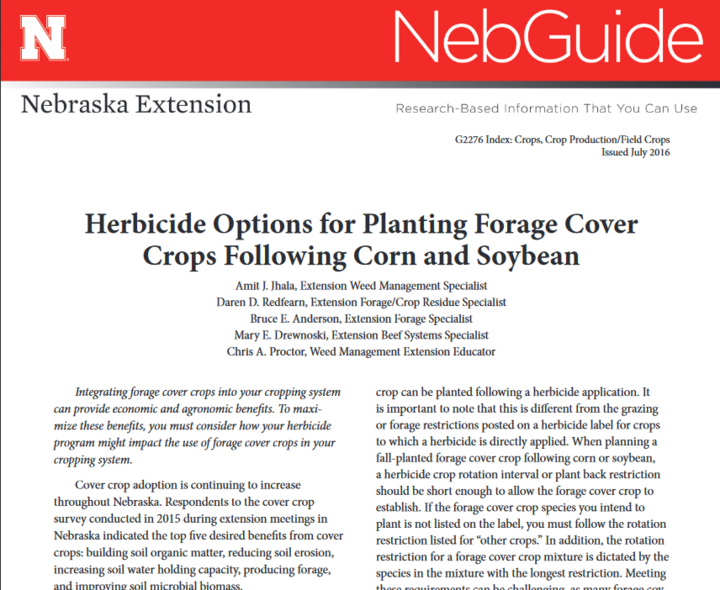If you're planning to plant cover crops this fall, particularly forage cover crops, you'll likely want to plant as soon after crop harvest as possible to assure the longest growing season possible for your cover crops. As you prepare for the hectic harvest season, this is a good time to check the label plant-back restrictions of any herbicides applied previously in the field as you plan your cover crop planting and use.
Following are two resources with further information on herbicide considerations when planting forage cover crops.
Herbicide Options for Planting Forage Cover Crops after Corn and Soybean, a March 2016 CropWatch article. This article outlines what to consider and includes Herbicide Label Plant-Back Restrictions, as of the publication date, for pre- and post-emergence in corn and soybean. Always check the herbicide labels for the products previously applied and use the most restrictive plant-back restrictions applicable. See the 2017 Guide for Weed, Disease, and Insect Management in Nebraska for more information on herbicides labeled for use in Nebraska and their restrictions. Read More

Herbicide Options for Planting Forage Cover Crops Following Corn and Soybean (Nebraska Extension NebGuide G2276) by Nebraska Extension Specialists Amit Jhala, Daren Redfearn, Bruce Anderson, Mary Drewnoski, and Chris Proctor. As the use of cover crops increases in Nebraska, with many acres being planted after corn and soybean harvest, this publication looks at herbicide recommendations in respect to forage cover crops and includes tables fof Herbicide Label Plant-Back Restrictions. Requirements for integrating forage cover crops within a herbicide program are the most restrictive of the cover crop uses. In the NebGuide the authors write:
"Most herbicide labels list crop rotation intervals or plant back restrictions that limit how soon a subsequent crop can be planted following a herbicide application. It is important to note that this is different from the grazing or forage restrictions posted on a herbicide label for crops to which a herbicide is directly applied. When planning a fall-planted forage cover crop following corn or soybean, a herbicide crop rotation interval or plant back restriction should be short enough to allow the forage cover crop to establish. If the forage cover crop species you intend to plant is not listed on the label, you must follow the rotation restriction listed for “other crops.” In addition, the rotation restriction for a forage cover crop mixture is dictated by the species in the mixture with the longest restriction. Meeting these requirements can be challenging, as many forage cover crop species are not listed on herbicide labels and as a result replant restrictions fall outside the ideal fall planting window. Hail or other crop damage, seed corn, and silage corn all provide opportunities for earlier forage cover crop planting; however, herbicide plant back restrictions still must be observed in these situations.

